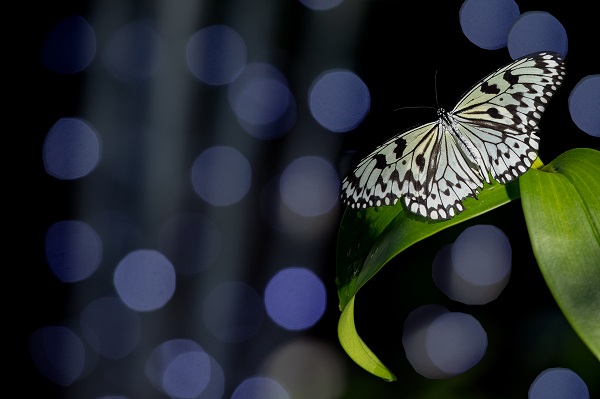
From now through January 5th, you can step into the Cockrell Butterfly Center for a truly unique Holiday event. You will be surrounded by beautiful white flowers and twinkling lights, while delicate white butterflies dance around you and festive music gets you into the holiday spirit.
This time of year, Houston’s mild climate can leave you wishing for a white Christmas, and we are delivering that to you in a very tropical way, by inviting hundreds of white butterflies to join us for the holiday season. These white butterflies are called rice paper butterflies, and they come to us from Southeast Asia. Rice Papers (Idea leuconoe), are one of the larger species we get here in the CBC, with a wingspan of up to 5.5 inches! We have them here all year-round, but right now, they appear to be everywhere, like snowflakes gliding through the rainforest. Rice papers are some of our most popular butterflies due to their large size, slow floppy flight, and delicate appearance. They also land on people more than most other butterflies in our conservatory. Butterflies of this species, especially the males, are highly attracted to chemicals in various lotions, body sprays and other products. If one lands on you, watch it carefully as it may be “tasting” you with its straw-like proboscis. By gathering up and ingesting these chemicals, the male butterflies can use them to synthesize pheromones that attract female butterflies.

If rice paper butterflies look very familiar to you, it’s because they are closely related to a very iconic Texas species, our beloved Monarch. Both of these butterflies belong to a large family known as Nymphalidae, or brush-footed butterflies. Brush-footed butterflies have a reduced front pair of legs, making it appear as if they have only 4 instead of 6. Monarchs and rice papers belong to a smaller subfamily called Danainae, or milkweed butterflies. There are approximately 300 species of milkweed butterflies worldwide. They all feed on plants in the family Apocynaceae, which includes milkweeds and other toxic plants. By feeding on these toxic plants, the larvae are able to store toxins in their bodies, making them poisonous and unpalatable to predators. They carry this toxicity into adulthood as well.
As adults, even though they live in different parts of the world, they all have very similar colors and patterns. This is a phenomenon known as Mullerian mimicry. The theory is that if they all have a similar visual appearance, predators will learn to avoid all of them with fewer experiences.
These charismatic beauties will be filling the conservatory all through the season and you can be a part of our White Christmas celebration until January 5th. White Christmas is included in your Cockrell Butterfly Center admission. Happy Holidays!

